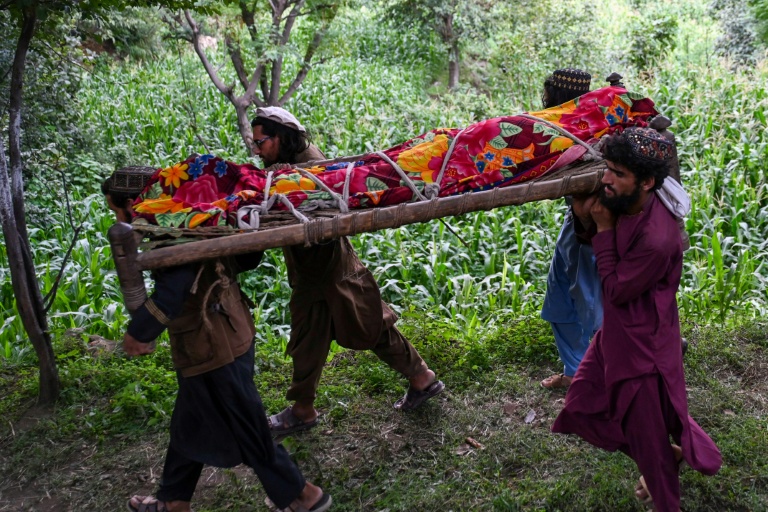World
Rescuers Hunt for Survivors After Afghan Earthquake Claims 800 Lives

Rescue operations are underway in eastern Afghanistan following a devastating 6.0-magnitude earthquake that struck on Sunday night, resulting in the deaths of over 800 people. The earthquake, which was felt in remote mountainous areas near the border with Pakistan, also triggered at least five aftershocks. The epicenter was located approximately 27 kilometers from Jalalabad and occurred at a shallow depth of just 8 kilometers, according to the United States Geological Survey (USGS).
The head of the Kunar Provincial Disaster Management Authority, Ehsanullah Ehsan, confirmed that rescue efforts continued throughout the night. “Operations continued throughout the night,” he told the press. He noted that there are still injured individuals in distant villages requiring urgent evacuation to hospitals. Villagers have joined in the rescue efforts, using their hands to clear the debris of mud and stone homes that were destroyed.
Casualties include many children, with bodies being wrapped in white shrouds by local residents who prayed over them before burial. Some of the hardest-hit areas remain inaccessible due to blocked roads, complicating rescue efforts. The United Nations migration agency has reported that access to these regions is severely limited.
The earthquake has compounded an already dire humanitarian situation in Afghanistan, which has faced ongoing crises exacerbated by decades of conflict. Since the Taliban took power in August 2021, international aid has significantly decreased, further straining the impoverished nation’s capacity to respond to disasters. The United States was once the largest donor, but funding was drastically cut after January 2025.
In light of the tragedy, UN Secretary-General Antonio Guterres announced an initial emergency assistance package of $5 million and stated that the UN is working closely with local authorities to assess needs and mobilize support.
The toll from the earthquake varies, with Taliban authorities reporting 800 dead and around 2,500 injured in Kunar Province. An additional 12 deaths and 255 injuries were reported in Nangarhar Province, while Laghman Province also has numerous injuries. Reports indicate that many residents in the quake-affected areas are among the over 4 million Afghans who have returned to the country from Iran and Pakistan in recent years.
In a poignant reflection of the community’s distress, Ijaz Ulhaq Yaad, a member of the agricultural department in Nurgal, described the chaos: “There is a lot of fear and tension… Children and women were screaming. We had never experienced anything like this in our lives.”
Pope Leo XIV expressed his sorrow in a statement shared by the Vatican, saying he was “deeply saddened by the significant loss of life” caused by the earthquake. Afghanistan is susceptible to earthquakes, particularly in the Hindu Kush mountain range, where the Eurasia and India tectonic plates meet.
In a similar event, a 6.3-magnitude earthquake struck western Herat province in October 2023, claiming over 1,500 lives and damaging more than 63,000 homes. Another significant earthquake occurred in June 2022, when a 5.9-magnitude quake hit the eastern province of Paktika, resulting in over 1,000 deaths and leaving tens of thousands homeless.
As the search for survivors continues, the international community watches closely, hoping for a swift recovery for those affected by this disaster.
-

 Science2 months ago
Science2 months agoToyoake City Proposes Daily Two-Hour Smartphone Use Limit
-

 Health2 months ago
Health2 months agoB.C. Review Reveals Urgent Need for Rare-Disease Drug Reforms
-

 Top Stories2 months ago
Top Stories2 months agoPedestrian Fatally Injured in Esquimalt Collision on August 14
-

 Technology2 months ago
Technology2 months agoDark Adventure Game “Bye Sweet Carole” Set for October Release
-

 World2 months ago
World2 months agoJimmy Lai’s Defense Challenges Charges Under National Security Law
-

 Technology2 months ago
Technology2 months agoKonami Revives Iconic Metal Gear Solid Delta Ahead of Release
-

 Technology2 months ago
Technology2 months agoSnapmaker U1 Color 3D Printer Redefines Speed and Sustainability
-

 Technology2 months ago
Technology2 months agoAION Folding Knife: Redefining EDC Design with Premium Materials
-

 Technology2 months ago
Technology2 months agoSolve Today’s Wordle Challenge: Hints and Answer for August 19
-

 Business2 months ago
Business2 months agoGordon Murray Automotive Unveils S1 LM and Le Mans GTR at Monterey
-

 Lifestyle2 months ago
Lifestyle2 months agoVictoria’s Pop-Up Shop Shines Light on B.C.’s Wolf Cull
-

 Technology2 months ago
Technology2 months agoApple Expands Self-Service Repair Program to Canada









